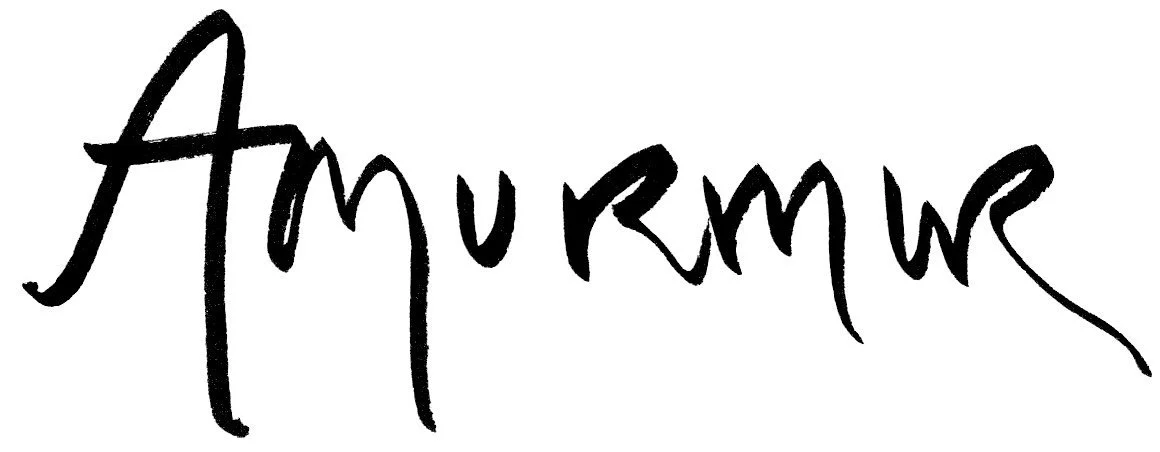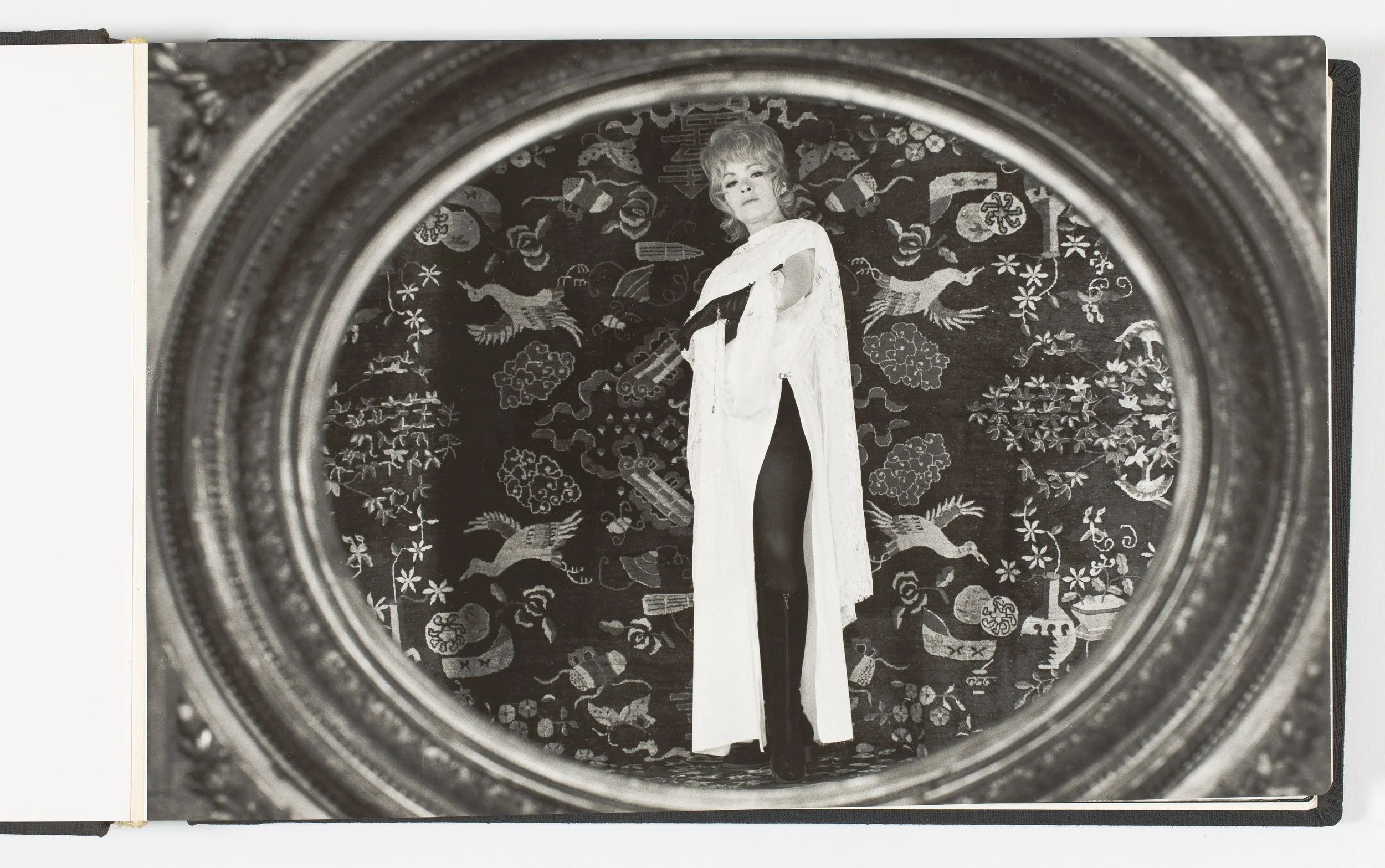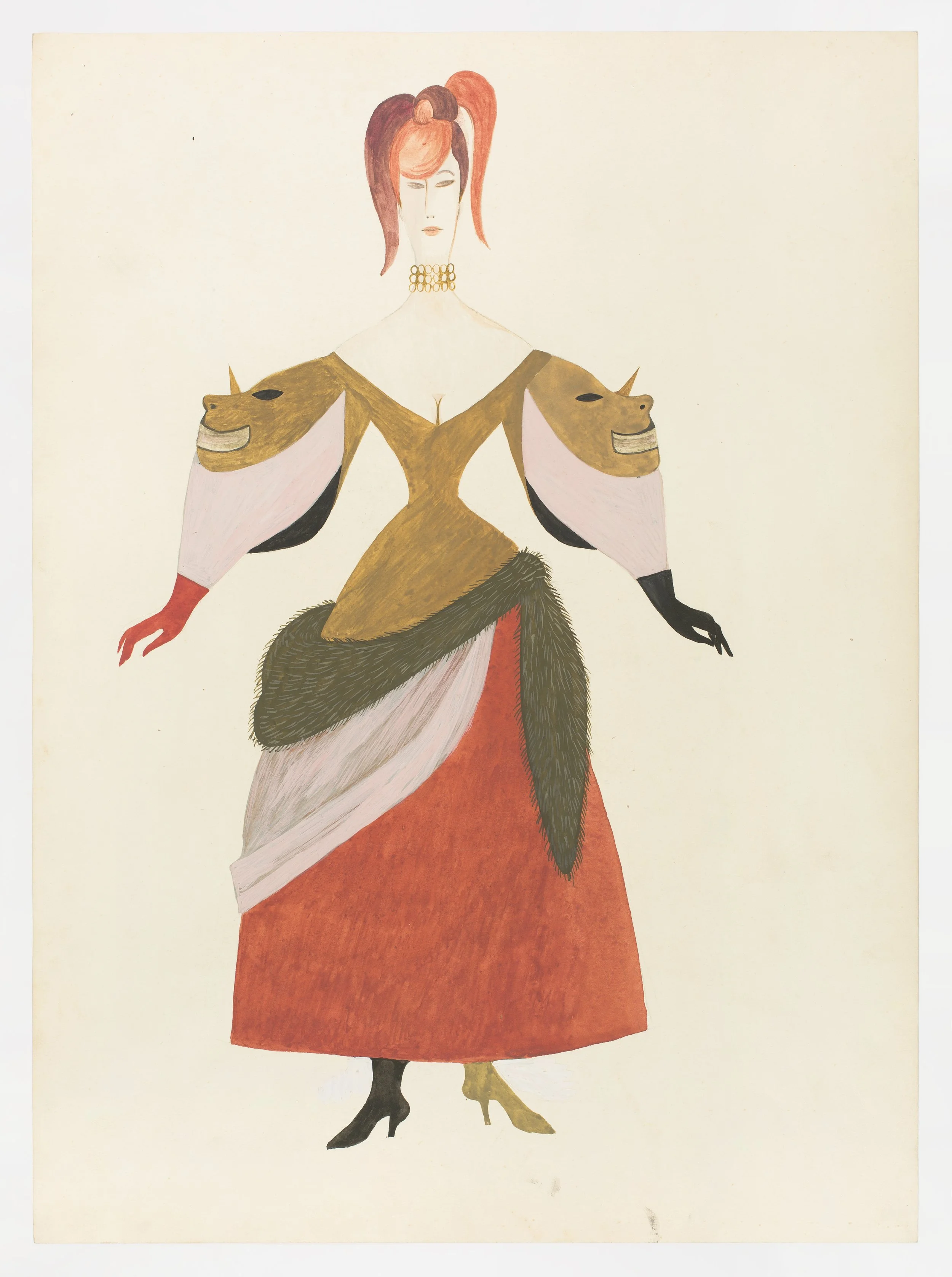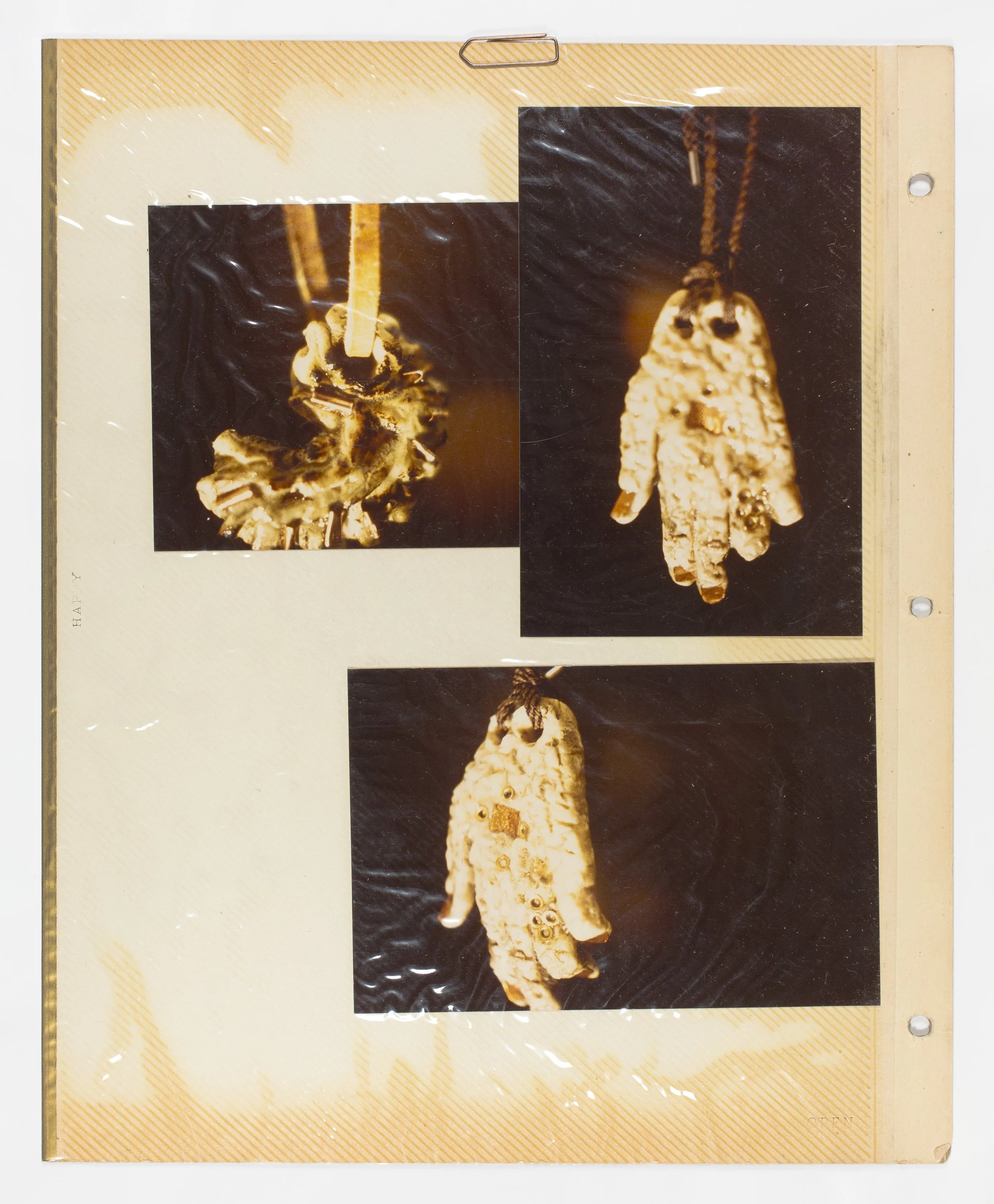The Archive of Ester Krumbachová
Arborescence in what is left behind
Ester Krumbachová and Miroslav Lamač (?), Untitled, undated. Polaroids on paper, 17.8 × 32.5 cm. Ester Krumbachová Archive, 2019, reference no. EK000091_0001.
In Le Gout de l’Archive, Arlette Farge outlines the isolating nature of archives. The reader pictures a lone researcher, hunched over olden pages and pockets of dust. History’s secretaries become all too aware of contact from other investigators: sometimes they yearn for nods, forbidden smiles. They otherwise they do their utmost to avoid them. Speaking the language of silent secrecy within a room of other people, the thirsty archivists will go about unlocking things classified, unable to resist the temptation of gentle gatekeeping. When locked away, archives become a site of rivalry. When in a vault, artefacts are inaccessible hotbeds of combustible knowledge. Noiseless competition with other library rats is not uncommon: the hunched figures worry about that other person, afraid someone will get to the answers before them. They want to sweep history’s confusion off the riddles another was equally puzzled by. An archivist is unable, throughout, to shake off the haunting feeling that an unconnected someone will unravel the past before them. This is the curse that accompanies the preservation of history. Institutions and rules within these bolted doors seem to wish to place a punctuation mark on the progression of and access to the past, with archival gloves as their mascot. There are, however, endeavours that disbar any sense of exclusivity. There are spaces that acquire objects through magic and serendipity, with public-spirited soldiers aiming to spread and share the love and mystery felt within boxes of a life. For a few years, the Ester Krumbachová Archive has done just that: it first revealed something lost, then brought to life the myriad connections Krumbachová had tirelessly spun throughout her personal life and career in a conscious effort to debunk the myth that the complexities within creativity must stay contrived to a specific end point.
Ester Krumbachová, Jumper, undated. Tempera on paper, 13 × 37.5 cm. Ester Krumbachová Archive, 2025, reference no. EK000503.
Amongst a towering number of credits, Ester Krumbachová is known for her work on Daisies, Valerie and Her Week of Wonders, Murdering the Devil, The Party and the Guests and plenty more. “It’s funny, you know. Over the years, most of the people who’ve had an in-person encounter with the estate, including all of us working on the online archive, have always called her by her first name, Ester. Even though we’ve never actually met her! We often say to each other, ‘Oh, Ester would like that!’ But how could we know?” The estate was made accessible in 2016 to Zuzana Blochová, Edith Jeřábková, Blaise Kirschner and a research group of students of AAAD. Hearing of the privilege they felt during the unwinding of Krumbachová’s life in objects illustrates the vigor with which the project participants wished to connect the things or stories of a leading member of Czechoslovak New Wave with the many branches that have regularly grown out of what she left behind. A conversation with Blochová about the guardian role of project editors and research fellows in the overall enigma concerning Krumbachová as a costume and set designer, screenwriter, director and artistic director makes evident the team’s devotion to understanding her mythical qualities. The feel of the conversation about their work with the life of Ester is welcoming: tidbits of personal, tasty information sprinkle over the sentiment they carry in regards to objects of her life finding new pathways of expression and interpretation. This is made equally apparent in a publication ESTER KRUMBACHOVÁ published in conjunction with the monographic exhibition of the same title at the House of Arts Brno (2021-22). Through numerous contributors and their visions, the archive evolves in a glistening way: the mind of Ester Krumbachová, which was already boiling in her time, emerges from static images thus ebbing and flowing into our consciousness. To share the work of Ester Krumbachová so generously, to render her objects unmysterious and accessible is a gesture almost unheard of in the archival world. It also speaks itself as an unmistakable clue that the project research team perceived the way Krumbachová wanted the effect of her work to carry itself: through connectivity and kinship. In terms of the more “renegade” archiving, Ester Krumbachová, perhaps disarmed by the display of her personhood, might have smiled at the hints of rebelliousness.
Ester Krumbachová, Costume design for the film Marian (1996), undated, c. 1995. Photocopy and colours on paper, 10 × 3.7 cm. Ester Krumbachová Archive, 2025, reference no. EK001300_0080.
Ester Krumbachová’s creative roles: Production and costume design (with Ondřej Nekvasil); dramaturgy (with Hana Jemelíková).
This adventure in Ester’s lands began in 2016 with artist and filmmaker Blaise Kirchner (FKA Anja Kirschner). ARE, an arts organisation led by Zuzana Blochová and Edith Jeřábková had invited Kirchner to curate an exhibition at UM Gallery of the Academy of Arts, Architecture and Design in Prague, where Jeřábková was teaching at the time. Parallel to the exhibition, Kirchner wanted to include a space for collective research on Krumbachová’s work as the starting point of their investigation revolving around a seminal Czech artist, and invite students to research and participate. At the time, Ester’s life was being safeguarded by her last partner, Ivo Paik, who was still living in her former home with the things she left behind. Over the years, many attempts had been carried out by historians and researchers to gain access to the trove of wonders clenched within the walls on Za Zelenou Liškou Street. “Even though we were assured that Ester's estate was inaccessible, or might even have been lost, Blaise kept saying they had a feeling something had to be done. They insisted that we at least try to contact Ivo.” The same way the curiosity of many others had led them to knock on Krumbachová/Paik’s door, the team tried their luck. As there was no answer, a letter explaining the project and intent was slipped under the door. The next day they received a phone call: the guardian of the precious vault was willing to meet them.
The website holding the archive works like an interactive cabinet of the accessible corridors of Ester’s mind. One click leads to another world taking you to fantasy in paper form. Perhaps you hunch, just like you would in a regular archive - you definitely blush when you see the nudes - you gasp when you see the amulets - you giggle when you read her stories - you smile when you see her artwork. Most importantly, you’re thankful you’ve been welcomed into Ester’s world and grateful for the friendliness sparking within it.
Ester Krumbachová, Noctary, 1972. Typewritten and handwritten text on paper, 21.5 × 28 cm, 66 pages. Ester Krumbachová Archive, 2025, reference no. EK002885_0008_0001.
The time travelling and show-and-tell first took place in the home Ivo Paik’s girlfriend, Jarmila Košnářová. Krumbachová’s things were unboxed piece by piece at a pace celebrating the complex process of releasing things left untouched since her death in 1996. As part of their desire to connect Ester with future generations, ARE invited practitioners to oversee the process with them, an early sign of the camaraderie surrounding the late artist, including a curator at the Museum of Decorative Arts in Prague. Ester Krumbachová’s estate was laid to rest there in 2022, but before that it was able to voyage and mould itself into peoples’ minds in many different ways.
Envelope of a letter from Miloš Kopecký to Ester Krumbachová, 1991. Handwritten text, stamp, postage stamp on paper, 11.5 × 22 cm. Ester Krumbachová Archive, 2025, reference no. EK001351_0001-0002.
ARE kept the archive in their office, rendering it an accessible tool. “Of course we were initially criticised. Even though we were very careful, we weren’t storing it in optimal, museum-like conditions, and interested visitors/people could view and explore it under our supervision. The digitisation of the estate was carried out entirely by students from art academies and from art-theory disciplines such as film studies.” In the archivist vernacular, this openness is sacrilege, but for a researcher, it’s a new kind of heaven. Having onlookers interpret and investigate the material feels like a respectful nod towards the mission Ester Krumbachová had been carrying out with her own creative output. Watching the films she was involved with and browsing her artefacts demonstrate a sizable web she had spun and was operating within. When a person joins the dots between their own universe and their own home, if they feed off of a plethora of references and objects, her own friends and their conversations, their œuvre then carries a similar feel: everything they touch, connects. Past her living, why choose to halt the communion she had with other people, beings and things? Our nearness with Ester’s life in the ARE headquarters was perhaps short lived, but in that window of time the junctions, the bonds, the synapses, the roots grew in length, size and shape. “Before passing it to the Museum of Decorative Arts, Paik made sure we would have the right to digitise the entirety of Ester’s archive and to carry out various interpretations of the work such as exhibitions.” They did just that and opened our eyes to worlds previously unseen: she practiced the good kind of magic, spoke to her cats, made amulets for her friends, kept and annotated recipes and letters she never sent. It was all treasured and digitised, because the things that furnished her home and world played a role in the fruition of Krumbachová’s creative output.
Photo book of production stills from the film Murdering the Devil (dir. Ester Krumbachová, 1970). Photo Jaromír Komárek, c. 1969. Black-and-white photograph on paper, 20.4 × 30 cm. Ester Krumbachová Archive, 2024, reference no. EK002395_0012.
Ester Krumbachová’s creative roles: Direction, story, screenplay (with Jan Němec), production and costume design, lyrics of the song The Abominable Snowman.
Strikingly, despite the archive finding its physical resting place within an institution, the project team's generosity hasn’t reached a plateau as today, still, they encourage discussion with the artefacts. Our conversation with Blochová was immediately welcomed and the offering of private links to additional material emboldened extra research. A casual mention of Ester’s work on Malá Mořská Víla (The Little Mermaid - dir. Karel Kachyňa 1976) sparked familiar surprise and magic, prompting revisitation and new imaginative viewing and deciphering of her hushed costume work in the film.
Behind the scenes, the team are currently devising plans to render ESTER KRUMBACHOVÁ, no longer available in English translation, accessible for further research. The publication is a collection of Ester’s objects and a gathering of contributors who speak of their own ways of encircling the cavern of the curious. One essay and think piece links to the next, contributors mention each other or sprout different discussions, quotes and otherwise unknown reminiscence and anecdotes pepper the copious celebratory texts dedicated to Ester. In the words of Pádraic E. Moore, “the archive has become a site of autonomous artistic creation.” (Yellow T-Shirt and Black Magic Perfume. Notes on the Archive of Ester Krumbachová.) On their own terms, in their own words and drawing from their own chosen relics of a life lived, writers and researchers guide the smitten reader through the truths and legends of her life. “The archive offers insights into some of these idiosyncratic practices and the interests that fuelled them such as alchemy, mythology, metamorphosis, sympathetic magic and the most mysterious of animals: the cat.” (Pádraic E. Moore Yellow T-Shirt and Black Magic Perfume. Notes on the Archive of Ester Krumbachová.) [A note from Amurmur: The quality of the writing and research in this book is so astounding, the most arduous task in revitalising a little of Ester has been to not excessively quote its contents.]
Production still from the TV show Bread and Salt (1973). Scan of a colour slide. Ester Krumbachová Archive, 2025, reference no. EK004000_0009.
Ester Krumbachová, Costume design for the theatrical performance The Love of Three Oranges (1961). Tempera and pencil on paper, 45 x 33 cm. Ester Krumbachová Archive, 2019, reference no. EK000528.
The writers involved in this project bemoan Ester’s cultural setbacks implemented by the Czech government, stating, one after the other, that the resurrection of Ester’s tangible everyday life in 2016 has saved us from the potential effects of a permanent exclusion. In 1967, a member of the government had deemed her work subversive. Despite working under aliases or as an invisible consultant in the period known as normalization,, Ester suffered in incalculable amounts. In her characteristic brave and resourceful nature, she nurtured her home and surroundings. She retreated and “her home became the locus of her ‘inner exile’ and the interior décor helped transform the living space into an alternative universe, keeping the pressures of the outer world at bay.” (Frances McKee, Agitation)
Ester Krumbachová, Amulet / Necklace, undated. Scan a colour slide. Ester Krumbachová Archive, 2025, reference no. EK004001_0020.
Her amulets are an often referenced funnel of magic. Unneglectable in their honesty, they were created with the intent of protection and luck, for herself and for her friends around her. They also became a way for her to acquire funds in extremely challenging financial times. The gris-gris offered portals into the incandescence of her spiritual outlook, a glance at their digitised versions immediately attests to their specialness. The archive itself contains photographs and details of the amulets shared by the friends the artist had gifted them to, who held on to the potency of the jewel’s kindness. Each gifted jewel came with a recipe and explanation describing their desired effects, another signifier that the collection of the maker extends in arborescence. One might perceive these blooming branches as a familial affair, where even the tags within the listings use the keepers’ initials for labeling. Each amulet encloses her magic, and each wearer is an encapsulation of the memory of Ester. When making jewellery for films, the details winked at the possibility of hidden realms, talismans surrendering to the flexibility with which Ester Krumbachová distilled power and protection. In Agitation, Frances McKee shares the words of Elisabeth Wennberg:
“It was made with such gentle care and personal effort. To me it became very special and I have always kept it with me during trying moments - in my private life or during work. Sometimes the necklace will attract so much attention that I have to keep it hidden. [...] Over time I have added small pieces of memories to it. This necklace has a magic essence - it speaks. And now here is Ester saying “Hello!” again through your mail! After all these years… if this is not magic I don’t know!”
We’re only on the second chapter of the publication and already we’re made aware of how remarkable her passage on earth was.
Production still from the film Valerie and Her Week of Wonders (1970). Photo Jan Kuděla. Black-and-white photograph, 23.7 × 29.6 cm. Ester Krumbachová Archive, 2019, reference no. EK000247.
Ester Krumbachová’s creative roles: Screenplay (with Jaromil Jireš), costume and production design.
Ester Krumbachová once stated that “a coffee cup has to be interesting.” (Lukas Skupa, The Architect of Film Images). On film sets, she would oversee special significance within each detail of what she created. Off screen and off stage, within her intimate orbits, she charmed what may ordinarily have been judged as benign and seduces us into the ordinary: recipes become orations and multiplex stories. These clues of a life contain “her unrestrained screams and momentary ideas that could serve as names of memories, books and pictures. One surprising source is her collection of recipes which, contrary to common use, contain self-reflective notes, running commentary written while recording the steps of preparing a dish.” (Libuše Heczková & Kateřina Svatoňová “I don’t feel like talking about anything. And still I write”: Conversations with Ester Krumbachová (in)between Fields) Letters kept and unsent were addressed to herself, to her friends, to her cats. It is through these outward articulations and intimate thought processes that Krumbachová’s psyche continues to unblur itself. Her profundity and wit particularly apparent in a fairy tale she concocted about a fashion show for vegetarians.
“At a fashion show for vegetarians a carrot appeared on the catwalk, decorated with a little sieve for chamomile tea and a vegetable mix. The vegetarians applauded. wildly, so she went to put on another costume—a glass of milk on wheels. [...] Then she came out wearing a slice of Emmental. She flirted with the vegetarians through the holes in the cheese and they were so bowled over that they jumped up from their seats crying bravo! bravo! Now, enormously pleased with herself she excited to put on another costume: this time it was cream of wheat sprinkled with chocolate, sugar, and softened butter. As she pirouetted and spun around, striking different poses in the spotlight, the porridge was drying out very quickly and several vegetarians, especially those in the front rows, felt sick as it took them back to their childhood.”
(Libuše Heczková & Kateřina Svatoňová “I don’t feel like talking about anything. And still I write”: Conversations with Ester Krumbachová (in)between Fields)
Ester Krumbachová, Jewellery design for the theatrical performance Macbeth (1978). Photographs on paper, transparent plastic foil, 29.7 x 21 cm. Archive of Šárka Hejnová. Ester Krumbachová Archive, 2024, reference no. SH000007.
Ester Krumbachová, My Cat Petříček, undated. Graphite on paper, 38.5 × 29 cm. Ester Krumbachová Archive, 2025, reference no. EK003012.
“Ester Krumbachová most often compared film costumes to phantoms,” (Šárka Gmiterková All Those Silhouettes, Colors and Hats: Ester Krumbachovà as a Costume Designer) and “repeatedly stressed that it was ‘not just clothes’ but rather an ‘event’ possessing an important intellectual dimension.” (Markéta Uhlířová The Costume Phantoms of Ester Krumbachová.) Within this pocket of her craft, Ester shimmered a very personal quality. Whether admired or criticized for her rejection of the standard notions of colour or historical accurate accoutrements, she relished the banishing of stereotypes which created a comfort and attraction for the off-kilter within the viewer. The use of spectral language to describe the cloth she was in charge of steers an understanding of its force: “a phantom possesses agency, a capacity to behave autonomously. It can intrude and unsettle, but it can also act as a messenger,” the costumes “make their presence felt and intervene in the story itself.” (Markéta Uhlrová The Costume Phantoms of Ester Krumbachová) One can only draw parallels between Krumbachová’s ideas of costume work and the ruling effect of the exploration of her archive through her artwork, notes, dreams, set design, stories, photographs and personal items. Her presence is felt, her philosophies have intervened and the desire to know all there is to know about her is ubiquitous. Amurmur recommends reading all pages and looking into all corners of the online collection as attempting to summarise their greatness proves an impossible task.
Ester Krumbachová, Untitled, undated. Photocopy of fingerprint and drawing on paper, 29.7 × 21 cm. Ester Krumbachová Archive, 2024, reference no. EK002489_0016.
Ester Krumbachová, Costume design for the film Jumping Over Puddles Again (1970). Photo Ivan Minář. Black-and-white photograph, 23 x 14.5 cm. Ester Krumbachová Archive, 2025, reference no. EK002600.
Ester Krumbachová’s role on the film: Costume and production design.
The work of the team behind the Ester Krumbachová Archive deserves huge, lasting, echoing applause. Though “it all fell in our lap very quickly and surprisingly,” the resourcefulness of the magicians who unveiled her to us perfectly carry and embody the creative vision of Ester, a fervent believer in connection, collaboration and community. Their unselfish ideas in regards to the open-ended vision concerning the use of her possessions consolidates their understanding of exactly who Ester Krumbachová was: their power as “not archivists, but people coming from the field of contemporary art and film theory” glows stronger still as myriad followers of Krumbachová’s legend have bounced towards and off of her all seeing-eyes. The showcasing of her pieces and the gathering of thoughtful and articulate insights and feelings about Krumbachová are roaring evidence she had really found her best possible archivists, ones who understood the sanctity of sharing. The Ester Krumbachová Archive are chroniclers who unleashed “this quirky genius caged so long so wrongly.” (Kyoo Lee Esterisque, Czech Her Back In: On the Bikini Retrofuturity of Daisies (1966) - A Brief FemPhilo Poetic Musing.) Though discovering this endeavour almost a decade after its commencement, it lives as a lasting gift to be hissed at, and perhaps bitten by the past, gladly letting ourselves be whirled and twirled around by the way Ester Krumbachová lived despite the silence imposed, and the way she continues to grow around and through whoever comes into contact with her belongings.
@ester_krumbachova_archiveWith many thanks to Zuzana Blochováwords: Alexia Marmara













